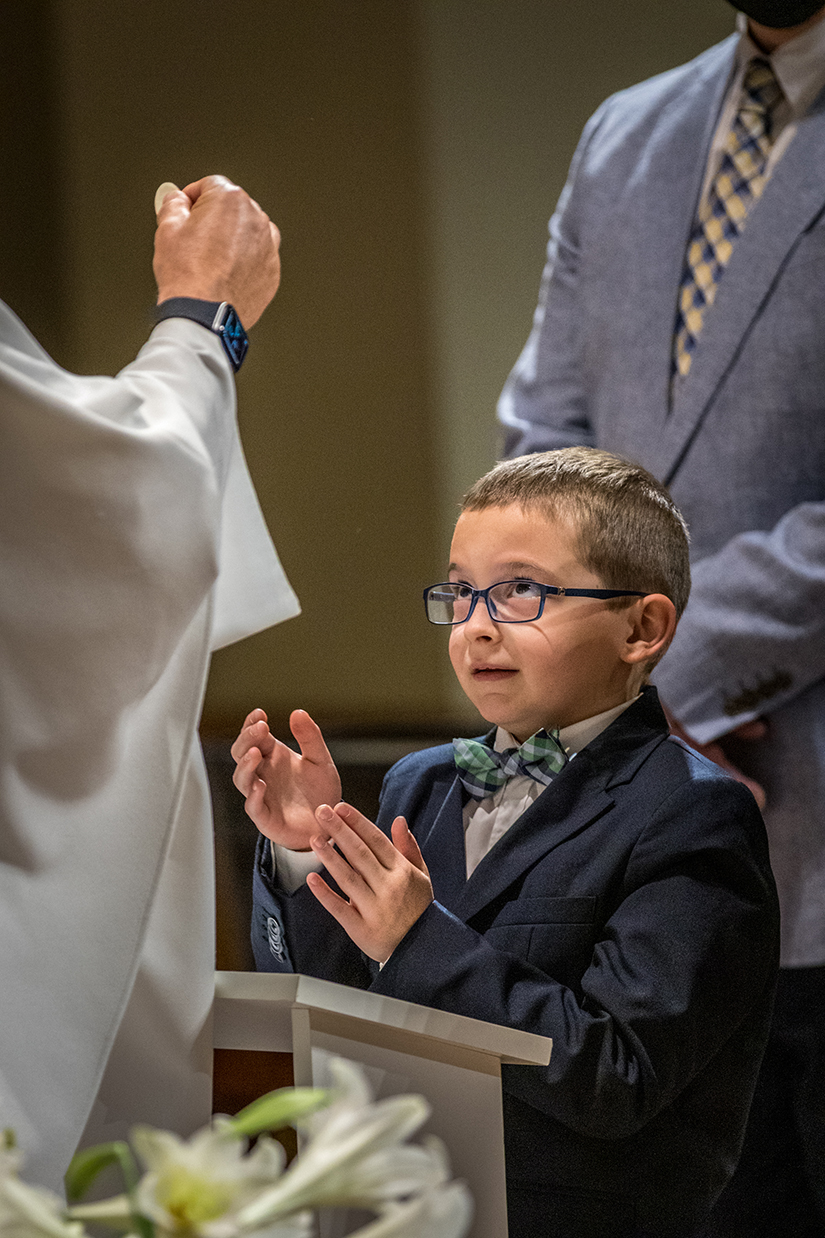 Billy Hoyer prepared to receive the Eucharist from Father Jack Siefert at St. Mary Magdalen Church in Brentwood April 11. Billy was one of 28 children who received their First Communion at the Mass.Photo Credits: Lisa JohnstonThirty years ago, Father Jack Siefert stood on the back porch at a parish rectory. He’d been having a bad day, and then saw Patrick, a second-grader, walk by, beaming.
Billy Hoyer prepared to receive the Eucharist from Father Jack Siefert at St. Mary Magdalen Church in Brentwood April 11. Billy was one of 28 children who received their First Communion at the Mass.Photo Credits: Lisa JohnstonThirty years ago, Father Jack Siefert stood on the back porch at a parish rectory. He’d been having a bad day, and then saw Patrick, a second-grader, walk by, beaming.
Father Siefert curiously asked the boy, “Why are you so happy?”
Patrick replied with a smile, “On Saturday, I get to receive Jesus for the first time.”
The boy’s excitement has served Father Siefert as a consistent reminder of the special nature of the Eucharist, which the Church describes as the “source and summit” of our Catholic faith. It is the Body, Blood, soul and divinity of our Lord, truly present in the gifts of bread and wine, and transformed through the prayers of the priest.
The Catechism of the Catholic Church explains that “the Holy Eucharist completes Christian initiation. The Eucharist is the heart and the summit of the Church’s life, for in it Christ associates His Church and all Her members with His sacrifice of praise and thanksgiving offered once for all on the cross to his Father; by this sacrifice He pours out the graces of salvation on His Body which is the Church” (CCC #1322, #1407).
Pope Francis has described communion as the “sacrament of love.”
“Together with baptism and confirmation, and it constitutes the source of the Church’s life itself,” the pope said. “From this sacrament of love, in fact, flows every authentic journey of faith, of communion, and of witness.”
Pastors and religious educators encourage families to help foster their children’s love for the Eucharist well beyond their first reception of the sacrament.
Physical and spiritual nourishment
Sammie Grone presents a scenario to second-graders preparing to receive their First Communion: They’re going to live on a deserted island and are allowed to bring three things.
“Almost all of them pick water, or bread or both,” said Grone, the coordinator of religious education for three campuses at All Saints Academy (St. Ferdinand, St. Rose Philippine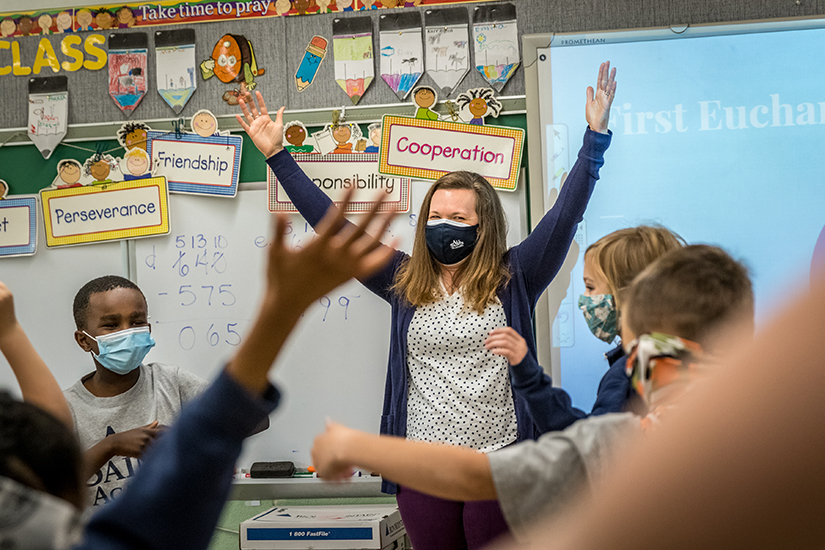 Sammie Grone, coordinator of religious education, gave a morning retreat on the Eucharist to second grade students preparing for First Communion at All Saints Academy at St. Norbert in Florissant on April 9.Photo Credits: Lisa Johnston Duchesne and St. Norbert). “Then I ask them, ‘Why would you pick that? Why are bread and water so important?’ We talk about survival and what we need to live.”
Sammie Grone, coordinator of religious education, gave a morning retreat on the Eucharist to second grade students preparing for First Communion at All Saints Academy at St. Norbert in Florissant on April 9.Photo Credits: Lisa Johnston Duchesne and St. Norbert). “Then I ask them, ‘Why would you pick that? Why are bread and water so important?’ We talk about survival and what we need to live.”
Grone uses the exercise to segue into the importance of living with Jesus in heaven after our earthly lives are finished. But she asks, what do we need to live with Jesus in heaven? We find examples in Scripture, such as the multiplication of the loaves and fishes.
“When Jesus raised His eyes and saw that a large crowd was coming to Him, He said to Philip, ‘Where can we buy enough food for them to eat?’ He said this to test him, because He Himself knew what He was going to do. Philip answered Him, ‘Two hundred days’ wages worth of food would not be enough for each of them to have a little [bit].’ One of His disciples, Andrew, the brother of Simon Peter, said to Him, ‘There is a boy here who has five barley loaves and two fish; but what good are these for so many?’ Jesus said, ‘Have the people recline.’ Now there was a great deal of grass in that place. So the men reclined, about five thousand in number. Then Jesus took the loaves, gave thanks, and distributed them to those who were reclining, and also as much of the fish as they wanted. When they had had their fill, He said to His disciples, ‘Gather the fragments left over, so that nothing will be wasted.’ So they collected them, and filled twelve wicker baskets with fragments from the five barley loaves that had been more than they could eat. When the people saw the sign He had done, they said, ‘This is truly the Prophet, the one who is to come into the world” (John 6:1-14).
The story is used to describe how Jesus tells us that He is the Bread of life. “It’s difficult to understand, but just as we cannot understand miracles, we know Jesus is God because He performs the miracles,” Grone said. “He’s trying to teach us something here.
“People need these things to survive, but Jesus is God, and we also need Him to survive. Jesus tells us, ‘I am the Bread of life,’” she said.
Grone said that parents are encouraged to help their children keep alive their love for the Eucharist well beyond First Communion. “It’s just as special and just as important the second, third and fourth time they receive, because it’s still Jesus,” Grone said. “The more parents can bring them to Mass and adoration to feel Jesus’ presence, the more children will embrace it and be excited about it.”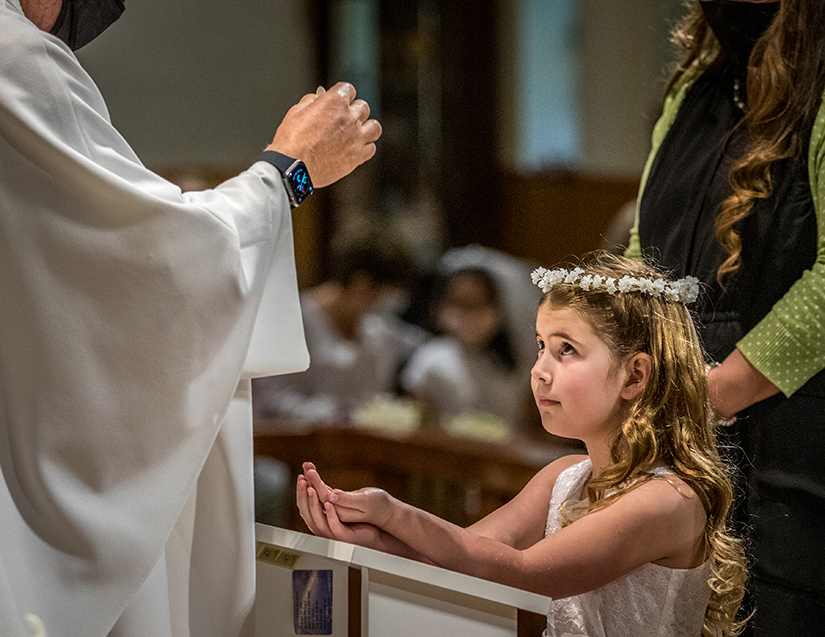 Mavis Forney received her First Communion from Father Jack Siefert at St. Mary Magdalen Parish in Brentwood on April 11. Pastors and religious educators encourage families to help foster their children’s love for the Eucharist well beyond their first reception of the sacrament.Photo Credits: Lisa Johnston
Mavis Forney received her First Communion from Father Jack Siefert at St. Mary Magdalen Parish in Brentwood on April 11. Pastors and religious educators encourage families to help foster their children’s love for the Eucharist well beyond their first reception of the sacrament.Photo Credits: Lisa Johnston
Close to Jesus
At Sts. Joachim and Ann School in St. Charles, second-graders receiving their First Communion participate in a special pinning ceremony. The program was virtual this year, but children receive a pin with grapes and wheat, which they’re invited to wear on the big day, and at church every Sunday thereafter, said Rose Wieschhaus, director of religious education at Sts. Joachim and Ann.
“We ask the children, do you promise to listen to God’s word at Mass, and to pray to Jesus every day?” she said. “Then we ask parents some questions that show support and encouragement of their children.”
Children sometimes have difficulty understanding the Real Presence of Jesus in the Eucharist, when the appearance of the bread and wine do not seem to change to the sense. “We tell them that God in His wisdom gives us something edible that we eat, but placed Himself in that as (spiritual) nourishment. We cannot always understand all of these things,” but that is part of the mystery of our Catholic faith, Wieschhaus said.
>> What is the Eucharist?
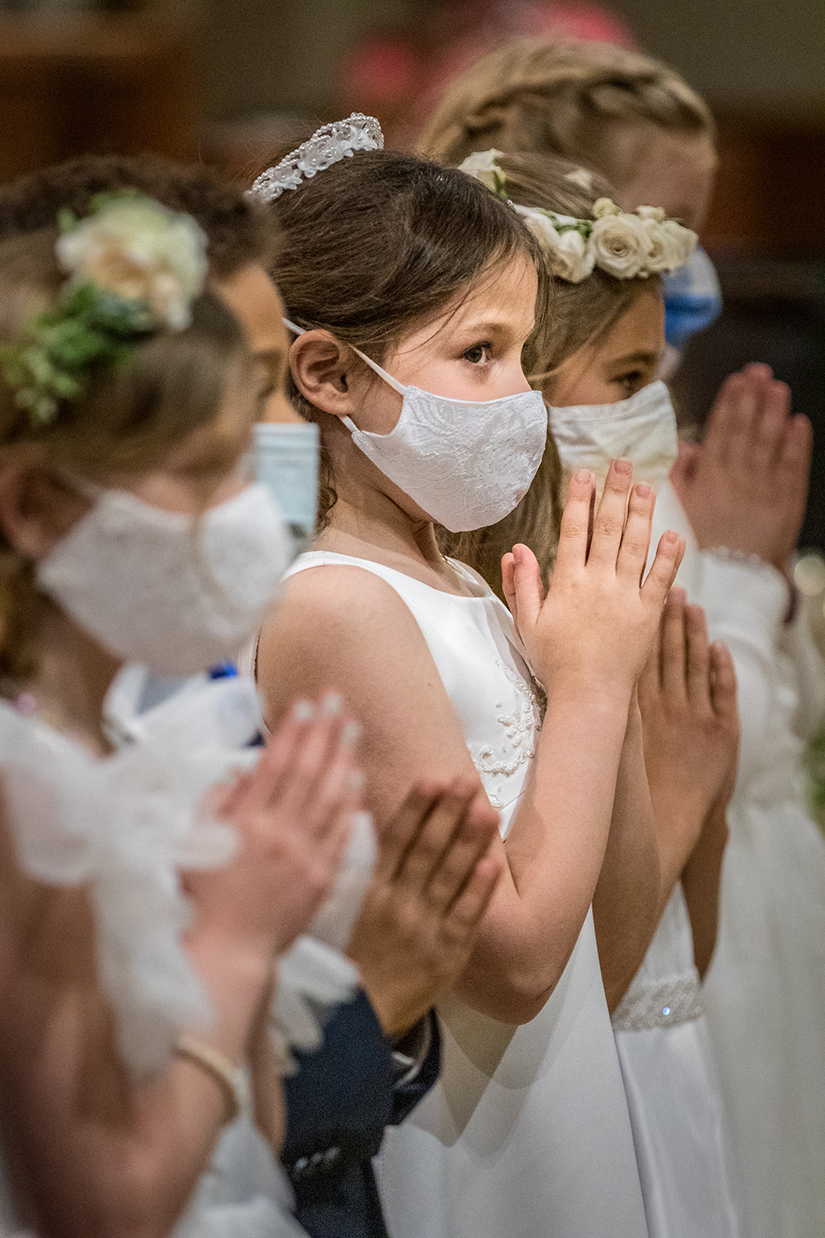 Charlotte Funk stood with her hands folded before the Mass at which she received her First Communion at St. Mary Magdalen Parish in Brentwood on April 11.Photo Credits: Lisa JohnstonThe term transubstantiation is used when bread and wine become the Body and Blood of Jesus. They do not become symbols of the Body and Blood; they become the actual Body and Blood of Jesus.
Charlotte Funk stood with her hands folded before the Mass at which she received her First Communion at St. Mary Magdalen Parish in Brentwood on April 11.Photo Credits: Lisa JohnstonThe term transubstantiation is used when bread and wine become the Body and Blood of Jesus. They do not become symbols of the Body and Blood; they become the actual Body and Blood of Jesus.
Different types of changes occur, even though our senses have not seen any change. For example, if a piece of paper is torn, it has changed. It’s still paper, but the appearance has changed. Some changes occur that can’t be seen. For example, when you learn something new, a change has occurred inside you, but it can’t be seen on the outside. You remain the same person as before.
When bread and wine are changed into the Body and Blood of Christ, they change completely; their substance change and they become Jesus, truly present. However, the appearances do not change; they still appear as bread and wine.
God has given us eucharistic miracles as examples of teaching us about the Real Presence of Jesus in the Eucharist.
>> The feast of Corpus Christi and eucharistic adoration
The Feast of Corpus Christi, also known as the Solemnity of the Most Holy Body and Blood of Christ, will be celebrated on Sunday, June 6. The feast is a celebration and reminder of the institution of the Eucharist.
The Corpus Christi procession is a centuries-old tradition of the Catholic faith to process the Real Presence of Jesus — the Eucharist — in public. The feast of Corpus Christi was established in Liege, Belgium, in 1247. Pope Urban IV extended it to the universal Church almost two decades later, and the Corpus Christi procession followed soon after. Centuries later, the tradition continues at many parishes in the Archdiocese of St. Louis, including at the Cathedral Basilica of Saint Louis.
The Archbishop’s Committee for Eucharistic Adoration was established under the leadership of then-Archbishop Justin Rigali in 1997 to foster conversion through prayer and the sacraments, and to revitalize participation in the Eucharist, with the primary emphasis on increasing participation in eucharistic adoration in the Archdiocese of St. Louis.
Prior to the pandemic, there were 160 parishes in the archdiocese that have offered times throughout the week for eucharistic adoration. There are 17 parishes that have perpetual adoration. The committee is currently updating its list of parishes that offer adoration.
“We have the great gift of the Eucharist that allows us to be in awe of God who remains hidden,” said Msgr. Timothy Cronin, chair of the Archbishop’s Committee on Eucharistic Adoration. Adoration is a perfect opportunity to spent quiet time in the presence of the Lord, outside of the context of Mass.
In his 2003 encyclical on the Eucharist, “Ecclesia de Eucharistia,” St. John Paul II wrote that “the worship of the Eucharist outside of the Mass is of inestimable value for the life of the Church. This worship is strictly linked to the celebration of the Eucharistic Sacrifice. The presence of Christ under the sacred species reserved after Mass — a presence which lasts as long as the species of bread and of wine remain — derives from the celebration of the sacrifice and is directed toward communion, both sacramental and spiritual.”
Families are encouraged to bring their children to adoration as often as they can, said Msgr. Cronin, who is senior associate pastor of St. Clement of Rome Parish in Des Peres. “Our Lord Himself would not hesitate to tell His disciples to leave for a time so He could be in quiet personal prayer with His Heavenly Father,” he said. “As God’s children we should do the same. We go to an out of the way space (in adoration), and the Lord invites us to encounter Him in a more profound way.”
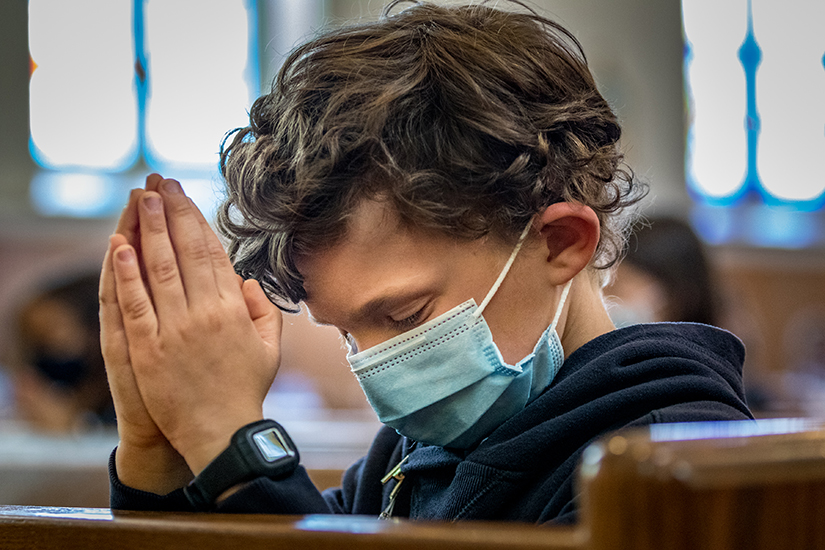 Grant Weilbaecher, a second-grader at Immaculate Conception School in Dardenne Prairie, prayed in the adoration chapel on April 12.Photo Credits: Lisa Johnston
Grant Weilbaecher, a second-grader at Immaculate Conception School in Dardenne Prairie, prayed in the adoration chapel on April 12.Photo Credits: Lisa Johnston